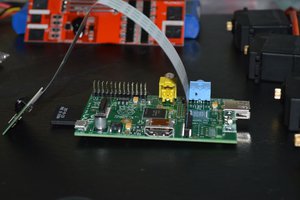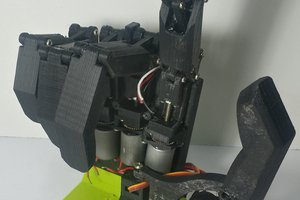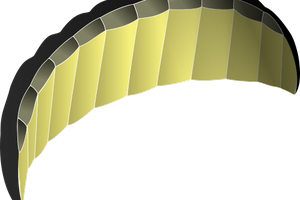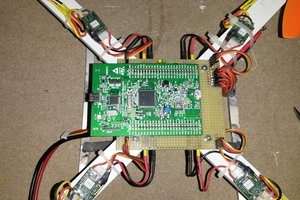We wanted a blimp that could be flown indoors, which requires a lot of maneuvering at very slow or no forward movement. So thrust vectoring is important so that it is possible to turn around or reverse course and maintain control. We went against using control surfaces that require airflow for control.
So we chose instead to use thrust vectoring. With two motors and two directional servos we would theoretically have 4 degrees of freedom. This would be forward/reverse, up/down, yaw left/yaw right, and roll left/ roll right. However all the micro-servos we could find were limited to 180 degrees, which meant we had no thrust in the -Z direction. This meant we had no ability to pull ourselves to the ground. This is easily solved by weighing the blimp just slightly heavier than air and letting gravity do our work for us. This has the side benefit of meaning that when the battery is dead and power is shut off, the blimp will come down.
We designed our own little control board with all the required elements on one board. This allowed us to cut the weight down of the blimp control elements from the hacked-together first prototype by about 64%. While it is unfortunate that the kids don't get to build the boards themselves, we have other kits that they can solder to get experience in that aspect of engineering.
The board itself has an ATmega328p, an XBee, a LDO regulator, and two 2A MOSFET switches for controlling the motors. Flyback diodes and tantalum capacitors to clean up the power lines. To keep things light, we wanted to run off a single 150 mAh battery from the blade nano qx. We have a lot of spare blade nano parts, if you can't tell. Too many unintentional brushes with reality. We used a single 3v3 regulator, and ran the arduino at 3v3 / 8 MHz. This had the added benefit of not requiring level shifters between the Xbee and the ATmega.
3D printed mount for the board and servo, 3D printed arms. 3D printed tie downs for the balloons to hold to the stick.
Please note that all the Eagle files, BOM, and code files can be found on the Github account published on the left. Please feel free to use this code for your project. Please spread it around to anyone wanting to use this for teaching kids how cool this stuff is!!!
 Steven Kibler
Steven Kibler
 8bithalfadder
8bithalfadder
 Martin Vincent Bloedorn
Martin Vincent Bloedorn

 hebel23
hebel23